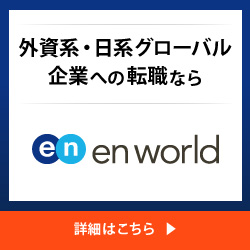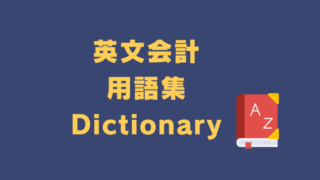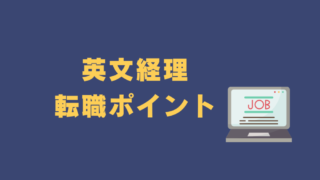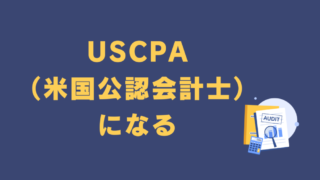英文会計の知識をさらに深めたい人のための無料講座 の問題集です。
当記事は、英文会計中級講座 に対応した問題集となります。
学んだことが理解できているか、確かめていただきます。
USCPA英文会計学院の「英文会計無料講座」が役に立つ人
- 「英文会計入門講座」「英文会計実務講座」で学習した人
- USCPA(米国公認会計士)のため、英文会計の学習をしている人
- ACCA(英国勅許公認会計士)の学習をしている人・しようと考えている人
- 仕事などで、英語で会計を理解する必要がある人
- 英語が得意で、会計の知識を身につけてキャリアアップしたい人
英文会計の最高峰資格は、USCPA(米国公認会計士)というアメリカの公認会計士資格です。
USCPAについて詳しく知りたい場合、アビタスというUSCPA予備校から資料を取り寄せてみてください(もちろん無料です)。
USCPAの短期合格のコツ・資格の活かし方は『USCPAになりたいと思ったら読む本』を読んでみてください。
英文会計中級講座<全6回>で学んだこと
英文会計中級講座 で学んだことは、以下のとおりです。
英文会計中級講座<全6回>で学んだこと
- 会計公準(Accounting Convention)ー4つ
- 会計の基本原則 ー4つ
- 低価法(Lower of Cost of Market: LCM)とは
- 棚卸資産(Inventory)の低価法(LCM)適用の際の時価(Market Value)ー2つ
- 低価法(LCM)の計算
- 外貨建取引(Foreign Currency Transaction)とは
- 取引時、期末時、決算時の取り扱い
- 貸倒引当金(Allowance for Uncollectible Accounts:AUA)とは
- 貸倒引当金(AUA)の計上 ー 引当金法(Allowance Method)
- 貸倒引当金(AUA)の金額の計算 ーPLから、BSから、年齢調べ(Aging)
- 貸借対照表(Balance Sheet:BS)上の表示
- 負債性引当金
- 有給休暇引当金(Vacation Liability)
- 製品保証引当金(Warranty Liabilities)
- 偶発債務(Contingencies)ー利益の場合、損失の場合
- 偶発損失(Loss Contingencies)ー財務諸表(Financial Statements:FS)への表示
- 後発事象(Subsequent Events)ー財務諸表(Financial Statements:FS)への表示
- 会社の所得にかかる税金の計上
- 消費税(Japanese Consumption Tax)の計上
- 預り源泉税の計上
- その他の税金の計上
練習問題 1-1
練習問題 1-1です。問題を解いてから、解答を見てくださいね。
(1)問題
選択肢4つの中から、正解を1つ選んでください。
The valuation of assets in the balance sheet is based primarily upon:
- what it would cost to replace the assets.
- cost, because cost is usually factual and verifiable.
- current fair market value as established by independent appraisers.
- cost, because in the event of liquidation, the assets would be sold at an amount equal to their original cost.
(2)解答
選択肢4つの中から、正解を1つ選んでください。
The valuation of assets in the balance sheet is based primarily upon:
- what it would cost to replace the assets.
- cost, because cost is usually factual and verifiable.
- current fair market value as established by independent appraisers.
- cost, because in the event of liquidation, the assets would be sold at an amount equal to their original cost.
解答は、②です。
貸借対照表(Balance Sheet:BS)の資産(Asset)項目についての、一般的な評価方法は、取得原価を基準にします。
なぜなら、事実に基づき検証できるからです。
練習問題 1-2
練習問題 1-2です。問題を解いてから、解答を見てくださいね。
(1)問題
選択肢4つの中から、正解を1つ選んでください。
Which of the following is not a generally accepted accounting principle relating to the valuation of assets?
- The historical cost principle -in general, assets are valued at cost, rather than at estimated market values.
- The economic entity assumption -activity of the economic entity is independent from that of its owner or other entity.
- The safety principle -assets are valued at no more than the value for which they are insured.
- The going concern assumption -one reason for valuing assets such as buildings and equipment at cost rather than at their current market values is the assumption that the business will use these assets, rather than sell them.
(2)解答
選択肢4つの中から、正解を1つ選んでください。
Which of the following is not a generally accepted accounting principle relating to the valuation of assets?
- The historical cost principle -in general, assets are valued at cost, rather than at estimated market values.
- The economic entity assumption -activity of the economic entity is independent from that of its owner or other entity.
- The safety principle -assets are valued at no more than the value for which they are insured.
- The going concern assumption -one reason for valuing assets such as buildings and equipment at cost rather than at their current market values is the assumption that the business will use these assets, rather than sell them.
解答は、③です。
一般的に認められている会計原則に沿っていないものは、③の「安全原則」です。
このような原則はありません。
練習問題 1-3
練習問題 1-3です。問題を解いてから、解答を見てくださいね。
(1)問題
選択肢4つの中から、正解を1つ選んでください。
Each year the accountant for the company adjusts the recorded value of each asset to its market value. Using these market value figures on the balance sheet violates:
- The economic entity assumption
- The historical cost principle
- The accounting equation
- The monetary unit assumption
(2)解答
選択肢4つの中から、正解を1つ選んでください。
Each year the accountant for the company adjustments the recorded value of each asset to its market value. Using these market value figures on the balance sheet violates:
- The economic entity assumption
- The historical cost principle
- The accounting equation
- The monetary unit assumption
回答は、②です。
会社の資産を毎年時価に評価替えするのは、取得原価の原則に違反しています。
練習問題 1-4
練習問題 1-4です。問題を解いてから、解答を見てくださいね。
(1)問題
選択肢4つの中から、正解を1つ選んでください。
The owner of A Company purchased a new car for his daughter who is away at college at a cost of 2,000,000 yen and reported this amount as car in the company’s balance sheet. The reporting of this item in this manner violated the:
- Historical Cost Principle
- Principle of Economic Entity Assumption
- Full Disclosure Principle
- Going-concern Assumption
(2)解答
選択肢4つの中から、正解を1つ選んでください。
The owner of A Company purchased a new car for his daughter who is away at college at a cost of 2,000,000 yen and reported this amount as car in the company’s balance sheet. The reporting of this item in this manner violated the:
- Historical Cost Principle
- Principle of Economic Entity Assumption
- Full Disclosure Principle
- Going-concern Assumption
解答は、②です。
自分の娘が学校に通うのに使う新車を業務用として貸借対照表(Balance Sheet:BS)に計上している会社のオーナーは、「企業実体の原則(企業活動とオーナーの私生活は分離していなくてはならない)」に違反しています。
練習問題 1-5
練習問題 1-5です。問題を解いてから、解答を見てくださいね。
(1)問題
Fill in the gap with appropriate word(s).
- The assumption that a company will continue indefinitely is known as .
- The principle requires assets to be reported at acquisition price.
- Recognition of revenue when realized or earned instead of when paid illustrates the principle.
- Depreciation purposes to allocate the asset cost over its useful life since the asset contributes to earn periodical revenue directly or indirectly. This is based on the idea of principle.
(2)解答
Fill in the gap with appropriate word(s).
- The assumption that a company will continue indefinitely is known as Going Concern.
- The Historical Cost principle requires assets to be reported at acquisition price.
- Recognition of revenue when realized or earned instead of when paid illustrates the Revenue Recognition principle.
- Depreciation purposes to allocate the asset cost over its useful life since the asset contributes to earn periodical revenue directly or indirectly. This is based on the idea of Matching principle.
練習問題 2-1
練習問題 2-1です。問題を解いてから、解答を見てくださいね。
(1)問題
選択肢4つの中から、正解を1つ選んでください。
When the market value to be determined by lower of cost or market method, if the replacement cost is greater than the ceiling the market value would be
- Selling Price
- Net Realizable Value
- Replacement Cost
- Floor
(2)解答
選択肢4つの中から、正解を1つ選んでください。
When the market value to be determined by lower of cost or market method if the replacement cost is greater than the ceiling the market value would be
- Selling Price
- Net Realizable Value
- Replacement Cost
- Floor
解答は、②です。
時価(Market Value)の決定の際、再調達原価(Replacement Cost:RC)が上限(Ceiling)=正味実現可能価額(Net Realizable Value:NRV)を超える場合は、正味実現可能額(Net Realizable Value:NRV)が時価となる。
練習問題 2-2
練習問題 2-2です。問題を解いてから、解答を見てくださいね。
(1)問題
選択肢4つの中から、正解を1つ選んでください。
Under the lower of cost or market method, what amount should be reported as year-end inventory value per below data?
- Original Cost:29,000 yen
- Selling Price:32,000 yen
- Cost for Sale:1,800 yen
- Current Replacement Cost:29,500 yen
- Normal Profit Margin:3,200
- 27,000 yen
- 29,000 yen
- 29,500 yen
- 30,200 yen
(2)解答
選択肢4つの中から、正解を1つ選んでください。
Under the lower of cost or market method, what amount should be reported as year-end inventory value per below data?
- Original Cost:29,000 yen
- Selling Price:32,000 yen
- Cost for Sale:1,800 yen
- Current Replacement Cost:29,500 yen
- Normal Profit Margin:3,200
- 27,000 yen
- 29,000 yen
- 29,500 yen
- 30,200 yen
解答は、②です。
上限(Ceiling):正味実現可能額(NRV):32,000-1,800=30,200円
下限(Floor):30,200-3,200=27,000円
再調達原価(Replacement Cost:RC):29,500円
取得原価(Acquisition Cost):29,000円
練習問題 2-3
練習問題 2-3です。問題を解いてから、解答を見てくださいね。
(1)問題
選択肢4つの中から、正解を1つ選んでください。
Under the lower of cost or market method, what amount should be reported as year-end inventory value per below data?
- Original Cost :21,000 yen
- Selling Price:24,000 yen
- Cost for sale:1,000 yen
- Current Replacement Cost:20,000 yen
- Normal Profit Margin:2,500 yen
- 20,000 yen
- 20,500 yen
- 21,000 yen
- 23,000 yen
(2)解答
選択肢4つの中から、正解を1つ選んでください。
Under the lower of cost of market method, what amount should be reported as year-end inventory value per below data?
- Original Cost :21,000 yen
- Selling Price:24,000 yen
- Cost for sale:1,000 yen
- Current Replacement Cost:20,000 yen
- Normal Profit Margin:2,500 yen
- 20,000 yen
- 20,500 yen
- 21,000 yen
- 23,000 yen
解答は、②です。
上限(Ceiling):正味実現可能価額(NRV)=24,000-1,000=23,000円
下限(Floor)=23,000-2,500=20,500円
再調達原価(RC)=20,000円
取得原価(Acquisition Cost)=21,000円
練習問題 3-1
練習問題 3-1です。問題を解いてから、解答を見てくださいね。
(1)問題
選択肢4つの中から、正解を1つ選んでください。
Which statement is incorrect if the company has foreign currency transactions?
- Transaction with foreign currency such as export or import is recorded with the exchange rate when incurred.
- When the balance at the fiscal year end described in foreign currency, it should be converted into the local or functional currency for the financial statements.
- Foreign exchange gain or loss is incurred due to change of currency exchange rate.
- The company can show two or more currencies in one financial statement if there are balances with various currencies.
(2)解答
選択肢4つの中から、正解を1つ選んでください。
Which statement is incorrect if the company has foreign currency transactions?
- Transaction with foreign currency such as export or import is recorded with the exchange rate when incurred.
- When the balance at the fiscal year end described in foreign currency, it should be converted into the local or functional currency for the financial statements.
- Foreign exchange gain or loss is incurred due to change of currency exchange rate.
- The company can show two or more currencies in one financial statement if there are balances with various currencies.
解答は、④です。
1つの財務諸表において、複数の通貨で示すことはできません。
練習問題 3-2
練習問題 3-2です。問題を解いてから、解答を見てくださいね。
(1)問題
以下の仕訳をしてください。
Journalize the following transactions in Japanese yen. The company is located in Japan and reports transactions in Japanese yen. Its fiscal year end is December 31 2021.
- Dec 18 2021:Bought merchandise of 500 US dollars for cash. The exchange rate was USD1=JPY120.
- Dec 23 2021:Sold merchandise of 1,000 Australian dollars on account. The exchange rate was AUD1=JPY70
- Dec 31 2021:Year-end. The exchange rate on the day was USD1=JPY110, AUD1=JPY80
- Jan 20 2022:Cash account collected from the sale on December 23 2021. The exchange rate was AUD=JPY60
(2)解答
以下の仕訳をしてください。
Journalize the following transactions in Japanese yen. The company reports transactions in Japanese yen. Its fiscal year end is December 31 2021.
- Dec 18 2021:Bought merchandise of 500 US dollars for cash. The exchange rate was USD1=JPY120.
Dr)Purchases 60,000
Cr)Cash 60,000
USD500×JPY120/USD1=JPY60,000
- Dec 23 2021:Sold merchandise of 1,000 Australian dollars on account. The exchange rate was AUD1=JPY70
Dr)Accounts Receivable 70,000
Cr)Sales 70,000
AUD 1,000×JPY70/AUD1=JPY70,000
- Dec 31 2021:Year-end. The exchange rate on the day was USD1=JPY110, AUD1=JPY80
Dr)Accounts Receivable 10,000
Cr)Foreign Exchange Gain 10,000
AUD 1,000×JPY80/AUD1=JPY80,000
JPY80,000-JPY70,000=JPY10,000
AUD建ての売掛金を換算替えしたことにより、売掛金残高は80,000円になります。
- Jan 20 2022:Cash account collected from the sale on December 23 2021. The exchange rate was AUD1=JPY60
Dr)Cash 60,000
Foreign Exchange Loss 20,000
Cr)Accounts Receivable 80,000
80,000円の売掛金が為替の影響で60,000円しか回収できなかったため、差額は為替差損となります。
練習問題 4-1
練習問題 4-1です。問題を解いてから、解答を見てくださいね。
(1)問題
選択肢4つの中から、正解を1つ選んでください。
Aging method is one of the ways to calculate the allowance for uncollectible accounts. Which of the following statement is incorrect regarding the aging method?
- Accounts receivables are categorized into cash collecting period.
- The method is based on annual sales.
- The longer the uncollected period is, the higher the uncollectible percentage becomes.
- One of the methods based on the accounts receivable balance at the year-end.
(2)解答
選択肢4つの中から、正解を1つ選んでください。
Aging method is one of the ways to calculate the allowance for uncollectible account. Which of the following is incorrect regarding the aging method?
- Accounts receivables are categorized into cash collecting period.
- The method is based on annual sales.
- The longer the uncollected period is, the higher the uncollectible percentage becomes.
- One of the methods based on the accounts receivable balance at the year-end.
解答は、②です。
練習問題 4-2
練習問題 4-2です。問題を解いてから、解答を見てくださいね。
(1)問題
選択肢4つの中から、正解を1つ選んでください。
Following information related to the accounts receivable in the company book of account at the year-end of December 31 2021.
- Accounts Receivable as of Jan 1 2021:5,000,000 yen
- Sale on account during 2021:40,000,000 yen
- Cash payment from the customers during 2021:37,000,000 yen
- Allowance for uncollectible accounts as of Jan 1 2021:800,000 yen
- Accounts written-off during 2021:200,000 yen
The company estimates 3% of the sales on account would be uncollectible.
Q1 What amount should be recorded as bad debt expense during 2021?
- 1,800,000 yen
- 1,600,000 yen
- 1,400,000 yen
- 1,200,000 yen
Q2 What is the balance of allowance for bad debt as of December 31 2021?
- 1,800,000 yen
- 1,600,000 yen
- 1,400,000 yen
- 1,200,000 yen
(2)解答
選択肢4つの中から、正解を1つ選んでください。
Following information related to the accounts receivable in the company book of account at the year-end of December 31 2021.
- Accounts Receivable as of Jan 1 2021:5,000,000 yen
- Sale on account during 2021:40,000,000 yen
- Cash payment from the customers during 2021:37,000,000 yen
- Allowance for uncollectible accounts as of Jan 1 2021:800,000 yen
- Accounts written-off during 2021:200,000 yen
The company estimates 3% of the sales on account would be uncollectible.
Q1 What amount should be recorded as bad debt expense during 2021?
- 1,800,000 yen
- 1,600,000 yen
- 1,400,000 yen
- 1,200,000 yen
解答は、④です。
売上高比率法(Percentage of Sales Approach)により計上する。
40,000,000 ×3%=1,200,000円
Q2 What is the balance of allowance for bad debt as of December 31 2021?
- 1,800,000 yen
- 1,600,000 yen
- 1,400,000 yen
- 1,200,000 yen
解答は、①です。
貸倒引当金(Allowance for Uncollectible Accounts:AUA)の期末残高は、以下のようになります。
期首+当期引当-貸倒れ=800,000+1,200,000-200,000=1,800,000円
練習問題 4-3
練習問題 4-3です。問題を解いてから、解答を見てくださいね。
(1)問題
選択肢4つの中から、正解を1つ選んでください。
Following information related to the accounts receivable at the year-end of December 31 2021.
| Days Outstanding | Amounts | Uncollectible Rate
(Estimated) |
| 0-59 | 20,000,000 | 1% |
| 60-119 | 10,000,000 | 2% |
| 120 and over | 5,000,000 | 4% |
| 35,000,000 |
The balance of allowance for uncollectible accounts was 300,000 yen at December 31 2021. During the fiscal year, 200,000 yen was written-off.
Q1 What the company applies aging method, what amount should be reported as allowance for uncollectible accounts in the December 31 2021 balance sheet?
- 700,000 yen
- 600,000 yen
- 500,000 yen
- 400,000 yen
Q2 When the company applies aging method, what amount should be reported as bad debt expense for the period from January 1 2021 to December 31 2021?
- 700,000 yen
- 600,000 yen
- 500,000 yen
- 400,000 yen
(2)解答
選択肢4つの中から、正解を1つ選んでください。
Following information related to the accounts receivable at the year-end of December 31 2021.
| Days Outstanding | Amounts | Uncollectible Rate
(Estimated) |
| 0-59 | 20,000,000 | 1% |
| 60-119 | 10,000,000 | 2% |
| 120 and over | 5,000,000 | 4% |
| 35,000,000 |
The balance of allowance for uncollectible accounts was 300,000 yen at December 31 2021. During the fiscal year, 200,000 yen was written-off.
Q1 What the company applies aging method, what amount should be reported as allowance for uncollectible accounts in the December 31 2021 balance sheet?
- 700,000 yen
- 600,000 yen
- 500,000 yen
- 400,000 yen
解答は、②です。
売掛金比率法(Percentage of Accounts Receivable Approach)による年齢調べ(Aging)では、売掛金(AR)残高にあわせて貸倒引当金(AUA)の残高を設定します。
20,000,000円×1%+10,000,000円×2%+5,000,000円×4%=200,000円+200,000円+200,000円=600,000円
Q2 When the company applies aging method, what amount should be reported as bad debt expense for the period from January 1 2021 to December 31 2021?
- 700,000 yen
- 600,000 yen
- 500,000 yen
- 400,000 yen
解答は、③です。
貸倒引当金(AUA)が600,000円である。
期首+当期引当-貸倒れ=期末
当期引当=期末-期首+貸倒れ=600,000円-300,000円+200,000円=500,000円
練習問題 5-1
練習問題 5-1です。問題を解いてから、解答を見てくださいね。
(1)問題
選択肢4つの中から、正解を1つ選んでください。
The company estimated the amount of loss that would incur if the company lost in a lawsuit. When the likelihood of the case was reasonably possible, a loss of contingency should be.
- Accrue as a liability but not disclosed.
- Disclosed and accrues as a liability.
- Disclosed but not accrued as a liability.
- Neither accrued as a liability nor disclosed.
(2)解答
選択肢4つの中から、正解を1つ選んでください。
The company estimated the amount of loss that would incur if the company lost in a lawsuit. When the likelihood of the case was reasonably possible, a loss of contingency should be.
- Accrue as a liability but not disclosed.
- Disclosed and accrues as a liability.
- Disclosed but not accrued as a liability.
- Neither accrued as a liability nor disclosed.
解答は、③です。
偶発債務(Contingencies)の場合、発生の可能性によって、以下のように対応が変わります。
- Probable:債務計上
- Reasonably possible:債務計上せず、注記(Footnote)として開示(Disclose)
- Remote:債務計上も、開示もしない
練習問題 5-2
練習問題 5-2です。問題を解いてから、解答を見てくださいね。
(1)問題
選択肢4つの中から、正解を1つ選んでください。
When the company accrues a loss contingency, the estimated rage of the loss would be 10,000,000 yen to 50,000,000 yen. If the possibility of the loss would be probable and there is no best estimate. What amount should be accrued?
- 0 yen
- 10,000,000 yen
- 30,000,000 yen
- 50,000,000 yen
(2)解答
選択肢4つの中から、正解を1つ選んでください。
When the company accrues a loss contingency, the estimated rage of the loss would be 10,000,000 yen to 50,000,000 yen. If the possibility of the loss would be probable and there is no best estimate. What amount should be accrued?
- 0 yen
- 10,000,000 yen
- 30,000,000 yen
- 50,000,000 yen
解答は、②です。
見積もり計上の際、以下のように対応をします。
- 金額が明らかなときは、その金額とします。
- 合理的な金額が一定範囲でしか見積もれない場合は、その中で最も可能性が高い見積金額を使用します。
- 見積もりの中に最も可能性が高い金額ない場合、最も低い金額で計上します。
練習問題 6-1
練習問題 6-1です。問題を解いてから、解答を見てくださいね。
(1)問題
以下の仕訳をしてください。
- At the fiscal year end of December 2021, A Company accrued income tax at 40% tax rate against net income of 80,000,000 yen.
- On April 20 2022, the company paid 30,000,000 yen final income tax for the year 2021.
(2)解答
以下の仕訳をしてください。
- At the fiscal year end of December 2021, A Company accrued income tax at 40% tax rate against net income of 80,000,000 yen.
Dr)Tax Expense/Income Taxes 32,000,000
Cr) Income Tax Payable 32,000,000
- On April 20 2022, the company paid 30,000,000 yen final income tax for the year 2021.
Dr)Income Tax Payable 30,000,000
Cr)Cash 30,000,000
練習問題 6-2
練習問題 6-2です。問題を解いてから、解答を見てくださいね。
(1)問題
以下の仕訳をしてください。
- A Company bought cash merchandise of 1,000 yen and paid 1,100 yen, 10% consumption tax included.
- The company sold merchandise on account at 5,500 yen, 10% consumption tax included.
- At the fiscal year end of December 31 2021, the company has following balances related to consumption tax. The company offset the balances and accrue consumption tax payable.
Prepaid Consumption tax 85,000 yen
Consumption Tax Receipt 120,000 yen
- The company paid consumption tax for the fiscal year ended December 31 2021.
(2)解答
以下の仕訳をしてください。
- A Company bought cash merchandise of 1,000 yen and paid 1,100 yen, 10% consumption tax included.
Dr)Purchase 1,000
Prepaid Consumption Tax 100
Cr)Cash 1,100
- The company sold merchandise on account at 5,500 yen, 10% consumption tax included.
Dr)Accounts Receivable 5,250
Cr)Sales 5,000
Consumption Tax Receipt 250
- At the fiscal year end of December 31 2021, the company has following balances related to consumption tax. The company offset the balances and accrue consumption tax payable.
Prepaid Consumption tax 85,000 yen
Consumption Tax Receipt 120,000 yen
Dr)Consumption Tax Receipt 120,000
Cr)Prepaid Consumption Tax 85,000
Consumption Tax Payable 35,000
- The company paid consumption tax for the fiscal year ended December 31 2021.
Dr)Consumption Tax Payable 35,000
Cr)Cash 35,000
練習問題 6-3
練習問題 6-3です。問題を解いてから、解答を見てくださいね。
(1)問題
以下の仕訳をしてください。
- The company paid 82,000 yen to the employees as follows.
Gross Salary:100,000 yen
Less Withholding income tax:18,000 yen
Net Payment:82,000 yen
- The company paid out tax withheld of 18,000 yen to the tax office.
- The company paid property tax of 5,000 yen
(2)解答
以下の仕訳をしてください。
以下の仕訳をしてください。
- The company paid 82,000 yen to the employees as follows.
Gross Salary:100,000 yen
Less Withholding income tax:18,000 yen
Net Payment:82,000 yen
Dr)Salary 100,000
Cr)Cash 82,000
Withholding Tax Receipt 18,000
- The company paid out tax withheld of 18,000 yen to the tax office.
Dr)Withholding Tax Receipt 18,000
Cr)Cash 18,000
- The company paid property tax of 5,000 yen
Dr)Sundry Tax 5,000
Cr)Cash 5,000
以上、「【英文会計無料問題集】英文会計中級講座 の練習問題と解答」でした。
自信がない場合は、「英文会計中級講座<全6回>」をもう一度復習してください。
よくできた場合は、「英文会計上級講座<全6回>」か、【英文会計無料問題集】英文会計上級講座 の練習問題と解答にお進みください。

英文会計の次のステップとしては、USCPA(米国公認会計士)がおすすめです。
USCPAは英文会計の最高峰資格です。
USCPAについては、USCPAどこさんの「USCPAどこのブログ」が詳しいです。
USCPAどこさんは、中央経済社より『USCPAになりたいと思ったら読む本』も出版。
USCPAになるまでのステップはUSCPAの始めかた【5ステップ】を参考にしてください。
USCPA予備校はUSCPA予備校4校を徹底比較!失敗しない学校選び が参考になります。
USCPA講座はアビタスがおすすめです。
╲資料請求・セミナー参加無料/
ほか、CPA会計学院もありますので、比較してください。
╲資料請求無料/
外資系・グローバル企業への転職で人気の転職エージェントはこちらです↓
╲登録無料/
╲登録無料/














